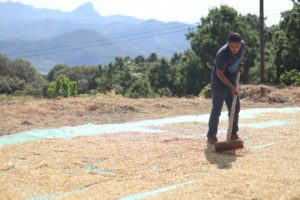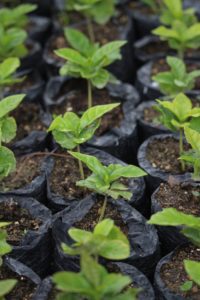When reading the front and back of a coffee bag while waiting for it to brew, or for the water to boil for your French press, you may wonder what the labels and stamps mean on the bag. If you’re not brewing your perfect cup, it may be in the coffee aisle at the grocery store that the labels puzzle you. When observing the bags for sale at your local coffee shop, you may ponder “What does Fair Trade mean?” or “Are single-origin coffees better than blends?” We’ll take you through the various designations for coffee and their meanings. 
Sustainability designations have to do with the growing process’s impact on the environment. Since sustainability designations are more important when the farm is first established, unless they’re using a host of horrible chemicals, this post will focus on the quality of the coffee beans and the trade arrangement.
Most designations pertain to the conditions under which the coffee was grown. Others have to do with the compensation and trade arrangements that got the coffee to the point where you could purchase it. In this post, we’ll cover the labels of fair trade vs direct trade coffee. We’ll also look at single-origins, blends and organic labels.
Overall, it’s important to know your coffee’s origins. Then, you can track the measures the grower and sourcer use to ensure it’s great coffee. It should also come from an arrangement that’s free of exploitation—one that doesn’t take advantage of anyone by paying too little for the coffee, labor or first transportation connections. Of course, it’s not realistic to think that everyone can purchase coffee that’s perfectly designated, but after this post, you’ll at least know what they mean so you can prioritize!
Fair Trade & Direct Trade
The terms “fair trade” and “direct trade” have to do with the steps that take the coffee from harvest to the location of sale. Trade designations aren’t only for the very wealthy and socially conscious consumer. That’s especially true when it comes to coffee crops. It’s impossible for most North Americans to buy local coffee, or even to buy relatively local coffee. Coffee doesn’t grow in the continental U.S., outside of a few questionable spots in California.
Considering that most coffee comes from the coffee belt in Latin America, consumers should pay attention. Many different crops have been grown in Central America through exploitation and unfair wages. Although large-scale slave-wage systems (companies) have been thwarted, it’s still important to ensure the growers are paid fairly. There’s a risk of growers operating at a loss for an extended period or making very little due to extreme weather, socio political turmoil and consumers not paying attention to their coffee’s sourcing.

Direct Trade
Direct trade is a broader term than fair trade. It prioritizes having few (or no) links in the chain of trade and having great quality coffee beans. The label “direct trade” doesn’t require a third party to approve it, unlike fair trade. The labels are often established by the coffee roaster.
Fair Trade
Fair trade certifications mean that a third party has determined that the coffee was grown and harvested under good conditions. That means the land was treated well and not exploited. The workers have rights and are treated fairly.
Organizations that can certify a product as “fair trade” include Fairtrade International, Fair Trade USA, World Fair Trade Organization, Fair for Life and Equal Exchange. Sometimes the words “Fair Trade” are slapped on products by the roaster or seller themselves. Unless they are certified by one of these two organizations, they’re only printed words. It’s similar to when a food item or cosmetic is labeled “organic” but is not certified.
Single-Origin vs. Blends
Since we have an entire post covering the difference between single-origins and blends, and showcasing the up-and-coming hotspot for single-origin coffee in Honduras, we won’t go into too much detail here.
Single-Origin Coffee
Single-origin coffees are labeled as such because the beans come from only one area. Usually, this means the same farm, and perhaps the same section of a farm. Choosing a single-origin reduces uncertainty. The beans’ origin and how they, the surrounding fruit and the coffee tree itself were treated are all factors that can be traced with single origins.
Besides certainty of origin, people love single-origins because they reflect the taste of coffee from that area, and even with variations for that season. While the flavor of blends gets balanced out to appeal to a wider, mainstream audience, single-origin coffees have an authentic taste profile. They can certainly be exotic!
Blends
Coffees designated as blends are comprised of beans from 2-4 different farms or regions. Most coffee shops use blends in coffee drinks like cappuccinos and lattes. Sellers like to create blends because they can guarantee the flavor better by using a combination of beans. Likewise, they can bring the flavor toward the middle, where it is palatable for more people. Sometimes crafters are trying to create an amazingly flavored blend—and many succeed!
Nevertheless, blends can be questionable because the origin of the beans isn’t always clear. Sometimes lesser quality beans are put in to lower the costs. They’re basically a less expensive filler. It’s much more difficult to track the origins of beans used in blends—and sometimes the people selling them don’t want you to be able to track anything.
Organic Designations
Certified Organic
The word “Organic” may end up printed on bags of coffee when it isn’t actually certified as organic. USDA-organic certification indicates that it wasn’t farmed with certain harmful pesticides, herbicides or fertilizers. The coffee seeds must not be genetically modified (GMO) for organic certification.
However, the USDA’s certification is far from perfect. For example, it only guarantees that the food product is 95% organic. Since it takes three years to get certified as organic, and 60% of coffee beans are grown by small farmers (under increasingly volatile climatic conditions near the equator) there aren’t many truly organic coffees. It’s difficult for small farmers in remote locations to get certified.

The Subida Difference – Human Judgment and Hands-on Care
Single-origin coffees can showcase the flavor of high elevations in the tropics, which is the prime location for coffee growth. Subida Coffee Co. employs fairly treated growers and harvesters who work at the direction of agricultural engineers. Both sets of employees are committed to the non-profit’s greater mission. There is no “chain” of production or vagueness of origin. Moreover, the Moses Project is a 120-acre farm that houses and educates teenage boys. They receive regular schooling and hands-on agricultural experience. It’s gourmet coffee for a great cause!
Workers hand-pick only perfectly ripe coffee. It’s inspected by hand before being bagged. It’s stored, then roasted in small batches in Memphis, Tennessee. When you can’t buy locally grown coffee, supporting the Moses Project’s gourmet Subida coffee guarantees more than just peace of mind and certainty of origin—you’re part of an educational, community-stabilizing effort in Honduras.

